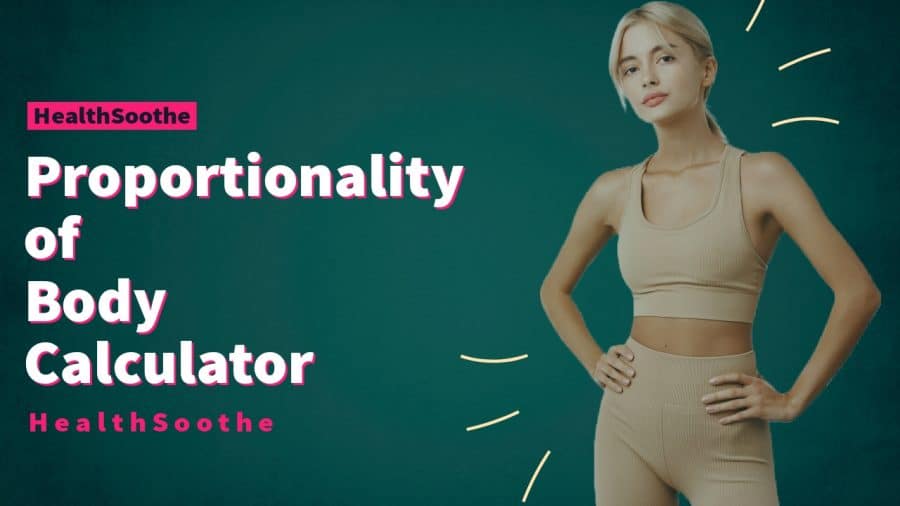The Proportionality of Body Calculator is a special tool that helps us figure out how well our body parts fit together. It does this by looking at certain measurements of a person's body.
By using the calculator, we can find out our body proportionality score. This score tells us how balanced our body is and if our different body parts are in good harmony with each other.
Knowing our body's proportionality is important because it can tell us if we are physically healthy. When our body parts are well-proportioned, it means that we are likely in good shape and our body is working well.
In this blog post, we will learn all there is to know about the Proportionality of Body Calculator. We'll also find out how to use it, why it is helpful for both men and women, and discover more interesting things about it.
- Proportionality of body Calculator
- Where and How to Take Measurements
- How to Use the Proportionality of Body Calculator
- What is body Proportionality?
- Different Types of Body Type for Women
- Different Types of Body Type for Men
- Benefits of Using a Proportionality of Body Calculator
- Limitations When Using a Proportionality of Body Calculator
- Bottom Line
Proportionality of body Calculator
[calc-appearance id=14]
Where and How to Take Measurements
Before using a proportionality of body calculator, it's important to know where and how to take measurements. Taking accurate measurements is crucial in determining your body proportionality.
Here are the recommended sites and techniques for measuring the following body parts;
Neck: To find out your neck measurement, wrap the measuring tape around the base of the neck, just above the collarbone and below the larynx (Adam's Apple). Ensure that you're not tightening or loosening up too much and the tape lies flat against the skin while taking this measurement. Make sure the tape is parallel to the floor.
Upper Arm: To find out your upper arm measurement, keep arms relaxed by hanging them down naturally on both sides. Then wrap the measuring tape around upper arm (located between the shoulder and elbow) at the midpoint. Make sure the tape is snug and not too tight.
Hip: For measuring hips, stand with feet together and relax your muscles. Wrap the measuring tape around the widest part of your hips and buttocks (typically around the area where the buttocks stick out the most). Make sure the tape is parallel to the ground.
Lower Leg: Sit on a chair or stool with your legs relaxed and feet flat on the floor, then wrap the measuring tape around the lower leg (located between the knee and ankle) at midpoint, ensuring it is parallel to the ground. Make sure the tape is not constricting or digging into your skin, allowing for a comfortable measurement.
Always ensure that you take measurements without clothing as they can alter readings significantly leading towards wrong results from calculations done through Proportionality of Body Calculator
How to Use the Proportionality of Body Calculator
Using the Proportionality of Body Calculator is a simple and straightforward process that anyone can do. It doesn't require an special training.
Here are the steps to follow:
Step 1: Gather the necessary measurements such as your lower leg, upper arm, hip and neck circumference.
Step 2: Input the measurements into the proportionality of body calculator based on their respective categories and click the "Calculate" button immediately you're done.
Step 3: The calculator will then analyze your proportions and generate an assessment of your body proportionality score for you automatically and display it on the screen.
What is body Proportionality?
Body proportionality refers to the balance and symmetry of body parts in relation to one another. This is often referred to as the "golden ratio", where certain measurements have a harmonious relationship with each other.
Essentially, having good body proportionality means that your body looks visually pleasing and well-balanced, regardless of your specific body shape or size. For example, even if someone has a larger lower half, they can still have good proportionality if their upper half balances it out.
Good proportionality can also be an indicator of overall health and fitness. When certain parts of the body are too small or too large in relation to others, it may indicate muscle imbalances or potential injury risks.
By using a tool like the Proportionality of Body Calculator, individuals can assess their own proportions and work towards improving any imbalances through targeted exercises and training programs
Different Types of Body Type for Women
Every woman's body is unique, with different shapes and sizes. However, there are some common types of body shapes that women fall into. One of the most popular ways to classify these types is through the use of fruit or geometric shapes.
Here are some common body types that are often used to describe women's body shapes;
- Apple Shape: This refers to women who carry their weight around their midsection, with a larger bust and slimmer legs.
- Pear Shape: This refer to women who have wider hips and thighs compared to their upper torso.
- Hourglass Shape: This refer to women who have a balanced bust and hip measurement, with a smaller waistline in between.
- Rectangle Shape: This refer to women who's hips, waist and bust measurements are almost equal creating a straighter figure
- Inverted Triangle Shape: This refer to women who tend to have broader shoulders than hips.
Different Types of Body Type for Men
Men's bodies come in various shapes and sizes, which can be classified into different body types. One of the most commonly used systems for classifying male body types is known as the somatotype classification.
Here are some common body types often used to describe men's body shapes;
- Ectomorph: The ectomorph body type is characterized by a slim build with long limbs and lean muscles. Individuals with this body type have difficulty gaining weight or muscle mass.
- Mesomorph: The mesomorph body type is characterized by well-defined muscles, broad shoulders, and a narrow waist. Men with this body type tend to gain muscle easily but also need to watch their diet to avoid excess weight gain.
- Endomorph: The endomorph body type has a rounder shape with more fat accumulation around their midsection. Men with this body type often struggle to lose weight but can develop muscular strength when they engage in resistance training
- V-Shaped: The V-shaped body type is characterized by broad shoulders and a narrow waist. Men with this body type tend to have well-developed upper bodies, with a broader chest and back.
- Triangle Shape: The triangle body type in men features broader shoulders and a narrower waist and hips. The upper body tends to be more developed and muscular compared to the lower body.
Benefits of Using a Proportionality of Body Calculator
Using a proportionality of body calculator can offer numerous benefits to individuals who want to improve their fitness and overall health.
Here are some benefits of using a proportionality of body calculator;
- It allows you to identify areas where your body may be out of balance. This knowledge can help guide your exercise routine, so you can focus on specific muscle groups that need more attention.
- It helps you set realistic and achievable goals for yourself based on your unique body type. By understanding your body proportions and composition, you can set targets for muscle development, fat loss, or overall body symmetry.
- Tracking changes in your proportions over time using the proportionality of body calculator can be motivating as you see progress towards achieving your ideal physique.
- By taking measurements consistently with a proportionality of body calculator, individuals also build awareness about what they eat and how much they exercise each day.
Limitations When Using a Proportionality of Body Calculator
While a proportionality of body calculator can be an excellent tool to determine one's body type and proportions, it has its limitations. It is essential to understand these limitations to avoid any confusion or unrealistic expectations.
- The accuracy of the results depends on the accuracy of the measurements taken. An incorrect measurement could lead to inaccurate results, which could affect how you perceive your body type and proportions.
- Using a proportionality of body calculator solely as a means for determining one's physical attractiveness is not recommended. The ideal beauty standard varies from culture to culture and changes over time; therefore relying on this calculator alone can create unrealistic standards that are unattainable for many individuals.
It is important to remember that everyone's bodies are unique; no two people have the same exact shape or proportions. Therefore using a single tool such as this calculator should only serve as guidance rather than something definitive when assessing overall health status.
Bottom Line
Understanding your body proportions can help you achieve a better sense of balance and symmetry in your physical appearance. With the use of a proportionality of body calculator, you can determine your unique body type proportions and make informed decisions about exercise routines, clothing choices, and even diet plans.
It's important to keep in mind that while this tool can be helpful, it should not be used as the sole determinant for health or fitness goals. Body Proportionality is just one factor out of many when it comes to overall wellness.
So embrace your unique shape and strive for balance rather than perfection. By taking care of yourself with regular exercise, healthy eating habits, and self-care practices like meditation or yoga, you'll feel confident in your own skin no matter what measurements are displayed on a calculator.

My name is Iyanu Kolawole, I’m a professional content writer and web developer. I have always been passionate about writing and developing my coding skills. I started my career as a content writer and have written for several companies and brands. I am also a skilled web developer and have built several websites for businesses and individuals.I am a hardworking individual who is always looking to improve my skills. I am constantly striving to learn new things and to be the best at what I do. I am also a very friendly person and enjoy working with others.
The content is intended to augment, not replace, information provided by your clinician. It is not intended nor implied to be a substitute for professional medical advice. Reading this information does not create or replace a doctor-patient relationship or consultation. If required, please contact your doctor or other health care provider to assist you to interpret any of this information, or in applying the information to your individual needs.


